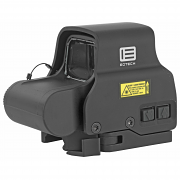OPTICS
 Shop by:
Shop by:
 Your results are being filtered by:
Your results are being filtered by:
- Manufacturer -> EOTech
Products
EOTech EXPS2-0 HOLOgraphic Weapons Sight
|
The EXPS2 offers true 2-eyes-open shooting and provides an unparalleled targeting experience. The all-purpose EXPS2 features easy-to-adjust side buttons and a quick-detach lever. It has a transversely-mounted lithium 123 battery. The increased height of the EXPS provides iron sight co-witness access in the lower third of the viewing window. Whether you're using the sight for law enforcement or hunting, the EXPS series sights are the premier optics in the line. |
EXPS2-0
In stock
$665.00
Title:A Guide to Gun Optics: Understanding the Different Types and When to Use Them
Intro:
When you first step into the world of firearms, one of the most overwhelming choices you'll face is optics. Red dots, holographic sights, LPVOs, magnified scopes—it can feel like learning a new language. But don’t worry—whether you're heading to the range, prepping for a hunt, or just building out your rifle, understanding the basics of gun optics is easier than you think. This guide breaks down the most common types of optics, what they’re good for, and how to choose what works best for you.
1. Iron Sights (Yes, These Still Count!)
Best for: Simplicity, backup sighting, close-range shooting
Before optics, there were iron sights—and they still have their place. Most shooters use them as backups or in minimalist setups. They’re durable, don’t require batteries, and help you master the fundamentals of aiming.
2. Red Dot Sights
Best for: Fast target acquisition, short to mid-range shooting
These are non-magnified sights that use a simple illuminated dot as an aiming point. Great for handguns, shotguns, and rifles, red dots are fast, intuitive, and ideal for home defense or competition shooting.
3. Holographic Sights
Best for: Tactical applications, shooting with both eyes open
Similar to red dots but with more complex tech, holographic sights (like those from EOTech) offer precise aiming, even if the glass is partially obstructed. They're popular in military and law enforcement circles.
4. Reflex Sights
Best for: Budget-friendly red dot alternative
Reflex sights are a type of red dot that reflect the reticle off a coated lens. They're lightweight and affordable, though often less rugged than higher-end options.
5. LPVOs (Low Power Variable Optics)
Best for: Versatility, AR platforms, 0–500 yards
LPVOs allow you to zoom from 1x (like a red dot) up to 4x, 6x, or even 10x. This gives you flexibility for both close and medium-range shooting. They’re a favorite among 3-gun competitors and modern tactical shooters.
6. Fixed Power Scopes
Best for: Simplicity, long-range consistency
These scopes have a set magnification—say, 4x or 10x. They're often more affordable and rugged than variable scopes, and great for rifles used at known distances.
7. Variable Magnification Scopes
Best for: Hunting, precision shooting, long-range versatility
These let you adjust zoom levels (e.g., 3–9x, 5–25x), ideal for engaging targets at varying distances. Hunters and precision shooters rely on them for dialing in accuracy at long range.
8. Prism Scopes
Best for: Compact, mid-range optics with etched reticles
Prism scopes use a prism instead of traditional lenses and offer better clarity in a smaller package. Some even work without batteries, thanks to etched reticles. Think of them as a hybrid between red dots and magnified optics.
Final Thoughts:
Choosing the right optic depends on what you shoot, how far you shoot, and your personal preferences. Start with what matches your use case, and don’t be afraid to try different types as your skills grow. The right optic doesn’t make you a better shooter—but the right fit definitely helps.

 Remove Filters
Remove Filters
